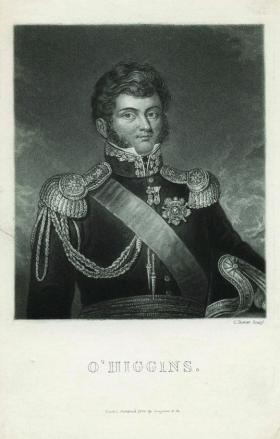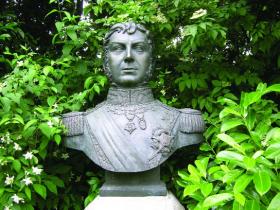Bernardo O’Higgins: rebel son of an Irish viceroy
Published in 18th–19th - Century History, Features, Issue 4 (Jul/Aug 2008), Volume 16
Bernardo O’Higgins—in 1823 he seriously considered going into exile in Ireland. (National Portrait Gallery)
In June 1823, six months after being ousted from government, Bernardo O’Higgins seriously thought about going into exile in Ireland. He had been under house arrest for six months at Valparaiso, Chile’s main port city, 60 miles west of Santiago, the capital. The new government had just given him permission to leave the country. He was 45, temporarily blind, financially broken and romantically hurt. He had a small family—his mother Isabel, his half-sister Rosa and a few servants, one of them possibly the mother of one of O’Higgins’s children. While he was Supreme Director of recently independent Chile he had fathered a son, Demetrio, who also lived with him, but the boy’s mother, Rosario Puga, tired of O’Higgins’s indecision and political problems, and unable to marry him because she was a divorcée, had run off with one of Bernardo’s political enemies. For the deposed head of state, Ireland was far enough away to allow him to forget and heal.
Background
O’Higgins was the son of a Sligo-born ‘wild goose’ who fled to Spain at 30, became a merchant, moved to South America, joined the king’s army and managed to become, at the end of his long life, viceroy of Peru. While serving in Spain’s never-ending war against the Mapuche in southern Chile, 54-year-old Ambrose Higgins (he added the ‘O’ at the end of his life) met the beautiful teenage daughter of a small-town mayor. Soon Bernardo was conceived, probably as a result of Ambrose’s unfulfilled promise of marriage (Spanish government officials were forbidden to marry locals). Father and son never met, but Bernardo’s education was always financed by his powerful father. The boy lived in Chile, Lima (Peru), Cádiz (Spain) and London. There the young man met Venezuelan Francisco Miranda, an early promoter of a free Hispanic America who was trying unsuccessfully to gain the support of the British government for his cause. Miranda won the lost and lonely young man’s heart, and recruited him into the secret lodge he had organised. But Ambrose forced the boy back to Spain, where he briefly lived in absolute poverty. When Ambrose died, however, most of the inheritance went to his son, who now found himself a rich man with a huge estate in the south of Chile. Back in Chile, Bernardo lived the life of a rich landowner, but the bells of war were tolling. By 1810, with Spain’s King Fernando VII Napoleon’s prisoner, a wave of independence movements swept the Spanish colonies: Buenos Aires had its first autonomous junta. Chileans were puzzled about what to do. They finally decided to go along with their neighbours and formed their own autonomous government.
O’Higgins initially not a main player
O’Higgins, who was not part of Santiago’s agrarian élite and was looked down on as a foreigner, became a member of Congress, but he was not a main player. He was a protégé of Juan Martínez de Rozas, the political chief of Concepción, the capital of southern Chile, who fiercely opposed José Miguel Carrera, the ill-tempered leader of Santiago’s rich landowners. But Martínez was an old man, and when the Spanish viceroy in Lima invaded Chile, Bernardo began to achieve fame. A bloody civil war began, one in which landlords became amateur officers who forced their servants and peasants to take arms against other servants and peasants. But in the service of Carrera and the patriotic cause, Bernardo O’Higgins was one of the few officers who battled shoulder to shoulder with his men. He had never received formal military training, but he had a fierce disposition in battle.
At the battle of El Roble in 1814, Bernardo managed to fight back and win even though Carrera fled the field. Bernardo’s popularity soared, along with his cri de guerre: ‘To die with honour or to live with glory’. Soon Bernardo replaced Carrera as the chief of the Patriot Army, even though he was reluctant to do so. From this moment on, Carrera and O’Higgins became enemies—they even fought each other at Tres Acequias, near Santiago, but had to shelve their differences and face a new Spanish army that had just arrived. Defeated by the Spanish at Rancagua, 40 miles south of Santiago, O’Higgins and Carrera blamed each other for the setback.
Exiled in Mendoza
![Political developments in nineteenth-century Latin America. (The Times Concise Atlas of World History [1982])](/wp-content/uploads/2013/03/68_small_1247563961.jpg)
Political developments in nineteenth-century Latin America. (The Times Concise Atlas of World History [1982])
With Carrera out of the picture, O’Higgins joined the Lautaro lodge, an offshoot of Miranda’s secret organisation. He became a loyal and close friend to San Martín, who managed to get enough funding from Buenos Aires to form a 4,000-strong army to invade Chile. They crossed the Andes in one of the most gruelling military expeditions ever: men, cannon, horses, mules, cows and bridges had to be transported over mountains more than 5,000 metres high at some points, with freezing temperatures and almost no water. Yet only a few men died.
With O’Higgins serving as one of his generals, San Martín defeated the royalists at Chacabuco on 12 February 1817 and took Santiago. The battle was almost lost by the Patriots because O’Higgins had digressed from San Martín’s battle plan. Nevertheless, the lodge decided that a Chilean had to be Chile’s leader, not San Martín, and O’Higgins was the obvious choice. The lodge became the shadow government. The war continued for some time in the south, and O’Higgins was nearly killed at Cancharayada.
Naval expedition to Lima
Next in San Martín’s plan was the naval expedition to Lima. O’Higgins supported him fanatically in this endeavour, and managed to financially ruin an already bankrupted country. Even though the royalists had been defeated and expelled from central Chile after the battle of Maipu in April 1818, the war dragged on in southern Chile. Yet O’Higgins preferred to invest in buying ships for San Martín’s expedition to Lima, and hired a very expensive former British naval officer, Lord Thomas Cochrane.
Bernardo’s government had its highs and lows. He was implicated in the killing of Manuel Rodríguez, a notorious Carrera supporter. Nor did he manage to restrain his friends in Mendoza from killing Carrera’s brothers Luis and Juan José in 1818. On the other hand, he stood up to the very royalist Catholic hierarchy and advanced reforms in education and health. He is also credited with important public works.
But Bernardo concentrated first and foremost on providing San Martín with a navy. San Martín finally did take Lima, but the mood in Chile wasn’t good. Ramon Freire, O’Higgins’s lieutenant and governor of Concepción, threatened him with civil war. In the south the war against royalist guerrillas had caused a terrible famine. Although unwilling at first, O’Higgins finally decided to step down and handed over power to Freire.

Bust of Bernardo O’Higgins in Dublin’s Merrion Square. (Nick Maxwell)
Exile
In the end O’Higgins didn’t leave for Ireland but for Lima, a city he had lived in during his early years. Although he had had correspondence with the Irish side of his family, the
now-independent Peruvian govern-ment had given him properties as a thank-you gesture for his efforts in building the navy. It is probable that he wasn’t so close to Ambrose’s family because as a young man he had had to compete for his father’s money with Ambrose’s brothers and nephews.
O’Higgins spent the remaining twenty years of his life in Peru. He joined Simon Bolívar’s army, which was engaged in fighting Peru’s royalists at Cusco, but didn’t witness any combat. He also (unsuccessfully) solicited Bolívar’s assistance for a return to Chile. In the end he became as Peruvian as he had been Chilean. He sided with Bolívar in his claim that Chiloe Island, in southern Chile, was part of Peru; and later, in the 1830s, he opposed Chile’s war against the Peru–Bolivia confederacy. He died from heart disease in 1842. That same year an Italian had brought the first daguerrotype to Lima, but Bernardo was too ill to get up and have his picture taken. All we have are old paintings and the echo of a myth that still resounds in Chile.
Alfredo Sepulveda lectures in journalism at Alberto Hurtado University in Santiago, Chile.
Further reading:
S. Clissold, Bernardo O’Higgins and the independence of Chile (London, 1968).
S. Collier, Ideas and politics of Chilean independence, 1808–1833 (New York, 1967).
A. Sepulveda, Bernardo, una biografía de Bernardo O’Higgins (Santiago de Chile, 2007).
L. Valencia Avaria, O’Higgins, el buen genio de América (Santiago de Chile, 1980).
















